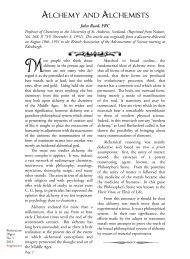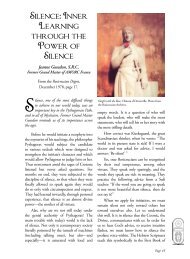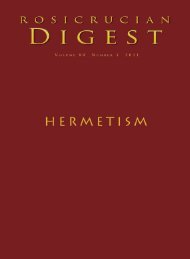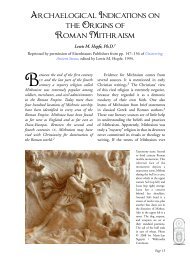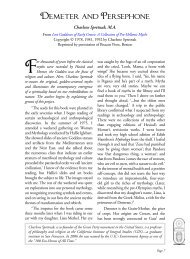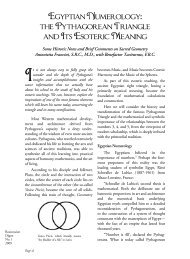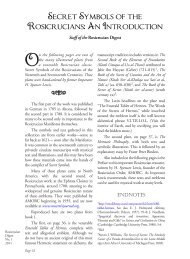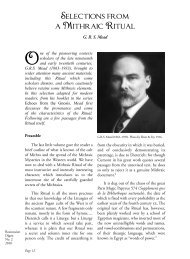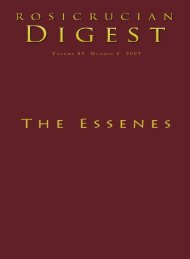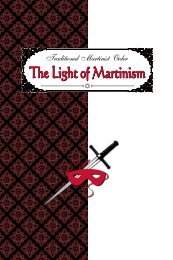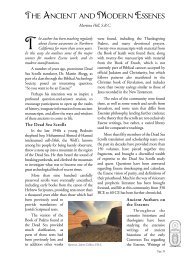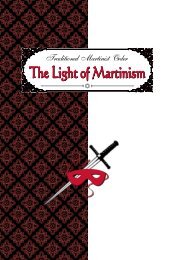Digest - Rosicrucian Order
Digest - Rosicrucian Order
Digest - Rosicrucian Order
Create successful ePaper yourself
Turn your PDF publications into a flip-book with our unique Google optimized e-Paper software.
<strong>Rosicrucian</strong><br />
<strong>Digest</strong><br />
No. 1<br />
2007<br />
America, and has compiled an impressive<br />
bibliography on esotericism and mystical<br />
spirituality. 27 Currently the editor of the<br />
online journal, Esoterica, 28 he is also the<br />
founding president of the Association for the<br />
Study of Esotericism which brings together<br />
scholars and students from across North<br />
America and promotes dialogue with<br />
European esoteric scholars and institutions.<br />
Versluis does not care to debate the<br />
question of the Egyptian source of wisdom<br />
and spirituality; rather, he chooses to begin<br />
this volume with a clear assertion of the<br />
ancient viewpoint:<br />
“There can be little doubt that whatever<br />
traditional symbology and metaphysics<br />
remain in the West today can be traced back<br />
to ancient Egypt, that land whose people, said<br />
Herodotus, were ‘scrupulous beyond all<br />
measure in matters of religion.’” 30<br />
Seeking what might remain of the Prisca<br />
Theologia for us today, Versluis analyzes the<br />
major characteristics of the Egyptian spiritual<br />
viewpoint. In Part One, he looks in turn at the<br />
concepts and practices represented by: Ma’at,<br />
the Primal Ennead, Isis, Osiris, the Second<br />
Death (when one becomes an Akh, an Effective<br />
of Voice), Typhon, Hermanubis, Ra–the Sun,<br />
the Two Lands, Sacred Language and<br />
Hieroglyphs, the Mysteries, and Apocatastasis<br />
(the restoration of all things). Part Two then<br />
delves into Initiation—its nature and practice<br />
in ancient Egypt and today.<br />
T h e E g y p t i a n My s t e r i e s i n a<br />
Wo r l d C o n t e x t<br />
The prose is spare and telegraphic.<br />
Versluis writes as an initiate, sometimes<br />
ending with the phrase, “More than this we<br />
cannot say.” 31 As he ranges through the topics<br />
of Egyptian mystical spirituality, his discussion<br />
is informed by his own considerable erudition<br />
of world esoteric and exoteric traditions,<br />
including Sufi, Hindu, Buddhist, and Judeo-<br />
Christian mysticism. Each chapter says just<br />
enough to give sufficient information and,<br />
more importantly, to inspire readers to go<br />
within for their own reflections.<br />
Page 42<br />
That is one of the secrets of this little<br />
book. While it is scholarly and connects<br />
Egyptian themes to world spiritualities, it is<br />
also very personal and individual. In the<br />
chapter on the Great Restoration which must<br />
follow the Kali Yuga (the end of all things),<br />
Versluis reminds us:<br />
“And indeed, if we succeed, if we tread<br />
that ancient path primordial, regardless of the<br />
blindness of our time, regardless of our<br />
distance from ancient Egypt, our lives can still<br />
reflect the Divine Sun, our world can still be<br />
translucent and alive —for that ancient path<br />
can never vanish, though it can for us be<br />
obscured. Yet if we enter upon it, it shall ever<br />
be the same, as it was and is, and ever shall be.<br />
And when it is so for us, each as individuals:<br />
that, that is the true Restoration, the true<br />
Apocatastasis. All else is anticlimactic.” 32<br />
The Initiatic Character of Ancient Egypt<br />
In addition to the Mysteries of Egypt and<br />
its initiations, Versluis reveals an Egypt much<br />
nearer the Zep Tepi (First Times). As did<br />
Schwaller de Lubicz, he conceives of Egypt as an<br />
initiatic culture in its totality, manifested most<br />
clearly in its spirituality. His sections on initiation<br />
discuss what can be salvaged from the ancient<br />
world, moving from the nature of initiation and<br />
symbolism in Egypt and throughout the world,<br />
to the work necessary for initiation, and finally<br />
to initiatory possibilities in our current age.<br />
Writing from the point of view of one at<br />
the end of an age, Versluis masterfully guides<br />
readers as candidates through this initiatic<br />
volume. It is the type of book that<br />
accomplishes what it is about. It is a kind of<br />
initiation into the Egyptian Mysteries it<br />
discusses. This will take place, as do all<br />
initiations, according to the mode of the<br />
readers and their times.<br />
The Egyptian Mysteries offers in true<br />
mystical fashion, only what is necessary for<br />
others to follow the path by one who has<br />
“done the work.” It is very unusual to<br />
experience such writing, at one time scholarly<br />
and mystical; however, in company with Peter<br />
Kingsley and a few others, Dr. Versluis has




